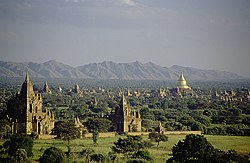King of Pagan
|
Bagan ပုဂံ Pagan |
|
|---|---|

Temples in Bagan
|
|
| Location of Bagan, Myanmar | |
| Coordinates: 21°10′N 94°52′E / 21.167°N 94.867°E | |
| Country | Myanmar |
| Region | Mandalay Region |
| Founded | mid-to-late 9th century |
| Area | |
| • Total | 104 km2 (40 sq mi) |
| Population | |
| • Ethnicities | Bamar |
| • Religions | Theravada Buddhism |
| Time zone | MST (UTC+6.30) |
Bagan (Burmese: ပုဂံ; MLCTS: pu.gam, IPA: [bəɡàɴ]; formerly Pagan) is an ancient city located in the Mandalay Region of Myanmar. From the 9th to 13th centuries, the city was the capital of the Pagan Kingdom, the first kingdom that unified the regions that would later constitute modern Myanmar. During the kingdom's height between the 11th and 13th centuries, over 10,000 Buddhist temples, pagodas and monasteries were constructed in the Bagan plains alone, of which the remains of over 2,200 temples and pagodas still survive to the present day.
The Bagan Archaeological Zone is a main attraction for the country's nascent tourism industry. It is seen by many as equal in attraction to Angkor Wat in Cambodia.
Bagan is the present-day standard Burmese pronunciation of the Burmese word Pugan (ပုဂံ), derived from Old Burmese Pukam (ပုကမ်). Its classical Pali name is Arimaddana-pura (အရိမဒ္ဒနာပူရ, lit. "the City that Tramples on Enemies"). Its other names in Pali are in reference to its extreme dry zone climate: Tattadesa (တတ္တဒေသ, "parched land"), and Tampadipa (တမ္ပဒီပ, "bronzed country"). The Burmese chronicles also report other classical names of Thiri Pyissaya (သီရိပစ္စယာ) and Tampawaddy (တမ္ပဝတီ).
...
Wikipedia

